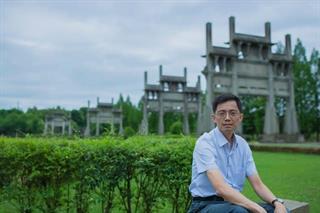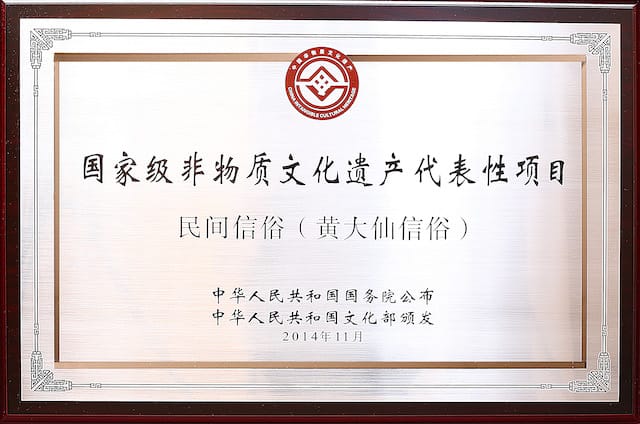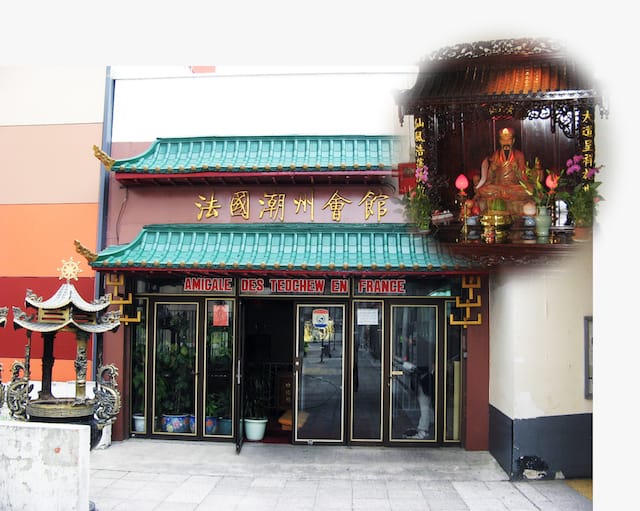Yao Chi-on
Centre for Hong Kong History and Culture Studies, Chu Hai College of Higher Education

Spreading the Wong Tai Sin Belief and Customs from Hong Kong to the World
Hong Kong’s authentic religious folk belief, the “Wong Tai Sin Belief and Customs” was formally included in the Fourth Batch of National List of Intangible Cultural Heritage of China in 2014, the first time a belief in an immortal of Hong Kong had been made a national intangible cultural heritage. Other cultural heritages were mostly festivals and performing arts. The Wong Tai Sin Belief and Customs has developed a combination of religious and charity characteristics, and is widely spread in Hong Kong and even to overseas Chinese communities.

*The Wong Tai Sin Belief and Customs of Hong Kong was formally included in the National List of Intangible Cultural Heritage of China (provided by Sik Sik Yuen)
Originating from Zhejiang, flourishing in Hong Kong
The Wong Tai Sin belief and customs originated in Jinhua, Zhejiang and spread to Lingnan during the Ming and Qing Dynasties. The belief established a foundation in Panyu, subsequently spreading to Huadi, relocating to Xiqiao, and flourishing in Hong Kong and Macao, where it has circulated for more than 100 years. In 1915, the Taoist priest, Liang Ren-an, of Puqing Altar in Xiqiao brought a vermilion portrait of Master Wong Tai Sin to Hong Kong and practiced “acting benevolently and teaching benevolence.” In 100 years and with abundant support, the Wong Tai Sin belief and customs is now a national intangible cultural heritage. In 1921, Liang Ren-an, Feng E-lian, and other Taoist priests chose to set up an altar at the current site in Chuk Yuen Village. This was initially named Cisong Seen Koon under the Puyi Altar. Sik Sik Yuen was officially established in August to manage the altar. In 1925, this was renamed to “Cisong Wong Tai Sin Temple”.
Intangible culture is characterized with human beings as the carrier and the host. The inheritance and continuation rely mainly on oral teachings from generation to generation. Sik Sik Yuen is the organization that carries the inheritance of the Wong Tai Sin Belief and Customs of Hong Kong. For nearly a century, it has followed Wong Tai Sin’s mission of “to act benevolently and to teach benevolence” and the virtue of “answering whatever he is asked for.” What is truly precious is that although three Wong Tai Sin temples had been abolished one after the other in Guangdong since the late Qing Dynasty to the 1960s, causing a discontinuation in the modern inheritance of the belief, Sik Sik Yuen Puyi Altar is now the only remaining temple dedicated to Wong Tai Sin. The torch of Taoism has been passed down to this day in this famous temple that has grown with the society of Hong Kong.
A district named after Master Wong Tai Sin, resting against Lion’s Rock
The site of Wong Tai Sin Temple is located in the middle of the Kowloon Peninsula, sitting in the north and facing the south, with its back to Lion’s Rock and front to Victoria Peak. The overall structure of the building is protected by the majestic mountain, giving it a state of calm and peace. Chuk Yuen, where Wong Tai Sin Temple is located, is an urban suburb that became densely populated when many immigrants flooded into the area from China after the war. Lower Wong Tai Sin Estate was completed in 1957, bringing great changes to the area. Wong Tai Sin is now a landmark that has witnessed the vicissitudes of life. By 1969, the area developed into a new community named after Wong Tai Sin. It was certainly unprecedented for a local administrative area to be named Wong Tai Sin District after a deity. This act reflected the role of Wong Tai Sin Temple as a famous landmark and acknowledged the good deeds it had done by “acting benevolently and teaching benevolence.” After the Kwun Tong to Yau Ma Tei line of the Mass Transit Railway (MTR) started operating in 1979, the Wong Tai Sin Station, Choi Hung Station, and Diamond Hill Station were also set up. Wong Tai Sin Temple has convenient transport and access as it is located just outside the exit of the MTR station. As a result, Wong Tai Sin has a unique geographical condition compared to the other temples of Hong Kong.
A union of religion and charity, a paragon of “to act benevolently and to teach benevolence”
Sik Sik Yuen Wong Tai Sin Temple has kept pace with the times without losing sight of its original mission. After establishing a number of diverse social services, Wong Tai Sin Temple has transformed from a traditional temple to a modern religious charity organization. “To act benevolently and to teach benevolence” is a principle of the Wong Tai Sin Belief and Customs that was established with the founding of the altar at the end of the Qing Dynasty, and has always been followed by worshippers in Hong Kong. In 1924, Sik Sik Yuen opened its first Herbal Clinic at Sai Kung Road, Kowloon, to provide free medical services and donate medicine. Later, the Yuen also provided care services for the elderly, published books of morality and virtues, and built schools to nurture talents to teach benevolence. The long-term adherence to the principles of “to act benevolently and to teach benevolence” in an immigrant society like Hong Kong has made it possible for the Wong Tai Sin Belief and Customs to represent the respect and closeness of the Hong Kong people to charity. The allegorical phrase that “Wong Tai Sin answers whatever he is asked for” is used to express the spiritual support and care of Master Wong Tai Sin for his worshippers, and means that prayers to Wong Tai Sin are very effective. Wong Tai Sin Temple has been flourishing since it first opened its doors to the public in 1956. In 2010, Sik Sik Yuen decided to become a “Green Organization” and make Wong Tai Sin Temple a “Green Temple” to contribute to environmental protection.
The belief and customs of Wong Tai Sin are folk customs related to immortals that use lifestyle to express worshippers’ belief and penetrate all aspects of daily life of the Hong Kong people. As for customs: People come to Wong Tai Sin for divinations to answer their queries and for medicine prescriptions. The return offering at the end of every year, the first incense of the New Year, and Master Wong Tai Sin’s Birthday on August 23 of the Lunar calendar have become important seasonal customs of Hong Kong. Sik Sik Yuen celebrated its 95th anniversary in 2016 and held the Wong Tai Sin Shangqi Ceremony to help worshippers establish a spiritual kinship between their children and Master Wong Tai Sin for blessings and protection. The Wong Tai Sin Belief and Customs in Hong Kong were inherited through the shangqi culture of Wong Tai Sin.
100 years of inheritance reaching the world
Incense is burned throughout the year at Wong Tai Sin Temple, and the temple is visited by worshippers and Chinese and foreign tourists, with the daily average number of admissions exceeding 10,000, showing the strong far-reaching influence of the temple. Sik Sik Yuen has redoubled its conservation and inheritance efforts ever since the Wong Tai Sin Belief and Customs was made a national intangible cultural heritage. In recent years, the Yuen has vigorously promoted the Wong Tai Sin Belief and Customs and strengthened its exchanges with other organizations in the region. For example, a group of disciples and Taoists were dispatched to hold a large Taoism Ritual to pray for Macao in 2017. Another example is the establishment of the Wong Tai Sin Temple by the Sabah State Government of Malaysia. Taoist priests of Sik Sik Yuen traveled all the way there to perform the groundbreaking ceremony for the establishment of the local altar on January 13, 2018.
Following the footsteps of Hong Kong worshippers, the Wong Tai Sin Belief and Customs has also been enshrined in Southeast Asia, Europe, the USA, and Australia. For example, people worship Wong Tai Sin at the Temple de L'Amicale des Teochew en France in Paris, the Qingyunnan Temple in Ho Chi Minh City, the Wong Tai Sin Yuanqing Temple in Sydney, Australia, and the Ching Chung Temple in Singapore. The Temple de L'Amicale des Teochew en France in Paris is a particularly noteworthy example as the worship of Master Wong Tai Sin and divinations for his worshippers only started there in recent years.
The establishment of the Sik Sik Yuen Puyi Altar in 1921 was a sign that the Wong Tai Sin Belief and Customs had taken root in Hong Kong, and it can be said that the process was an arduous one. Its significance as a belief has developed into a religious charity culture after being passed down and practiced in Hong Kong for a hundred years. One important aspect of the belief is that it has spurred the public’s enthusiastic participation in good deeds, benefiting the society as result. Looking at how various beliefs were spread, it can be seen that the Guan Gong Belief and Customs traveled to the whole world from Shanxi, the Mazu Belief and Customs traveled to the world from Fujian; and the Wong Tai Sin Belief and Customs traveled to the world from Hong Kong. Hong Kong is a link that connects the past and the future to spread the legend of the belief and customs of Master Wong Tai Sin.

*The Temple de L'Amicale des Teochew en France in Paris only started worshipping Master Wong Tai Sin and offering divinations for his worshippers in recent years (provided by the author)

*In December 2018, the Museum of the Prince Gong Mansion in Beijing held an exhibition called “The Oral Legacies: Intangible Cultural Heritage of Hong Kong”, which introduced the Wong Tai Sin Belief and Customs (provided by the author)